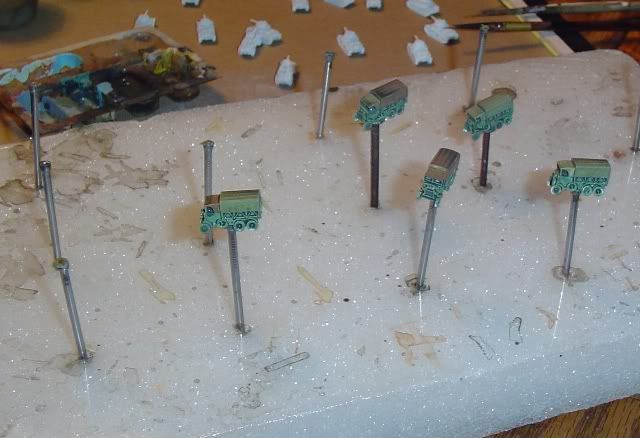I'm thinking that in some cases, like the excellent example 'copters (Peter's) you've chosen to try to emulated, the small touch of wash with "capillary" action may work very well. If there is a particular line you wish to highlight, spot-work may be best.
My own experience with the "wash and beat the whole model" approach has produced good results with ehancement of detail across a large variety of features and textures, both large and small ("large" within the context of micro armor, which ain't very large at all!). But I must admit that I have seen some features highlighted better in other people's work -- control surface seams on aircraft wings and tails stands out as one example in my thinking. I might try the spot application/capillary approach in future efforts.
As to getting "beaten" by the washing ... well, what the heck, keep trying! Its a hobby after all, not a job -- no one is going to fire you for doing it wrong (as in "not the boss's way").
I've had some failures in washing. Sometimes so bad that the models in question had to bet re- base coated. Others that just took a bit of extra work to "tone down", and still came out looking a bit different than their compadres. So what? I've never seen any two tanks that actually looked the same. Dirt, dust, mud, grime, and sun-fading accumulate at different rates on different vehicles. Rejoice in the "character" of your "not quite what I wanted" models.
Now, a practical tip or two...
I prime and base-coat with shake-a-can enamels. I do most of my detailing with brush and acrylics.
I don't use ink for washes. I use acrylics diluted with water. Depending on what my wash is, it may be heavily diluted at 10-to-1 or more (overall vehicle) or not heavily diluted at 2 or 3-to-1 (rust or mud on running gear).
One trick, learned hear on the forum, is to put just a touch of dish soap in the wash. Really. Just touch the brush to the nozzle on the dishsoap bottle by the sink before you stir it around in the diluted wash, or some such. It breaks up the surface tension of the water/paint, preventing it from beading up and encouraging it to flow into the cracks and crevases.
As to when to brush it off -- I go in with a flat-headed red sable brush and beat the models up when the wash has dried to the point of looking "sticky". In my case, I wash about 5 to 7 models, then go back and start beating the first one. OK, sometimes I'm a little early, and a model looses more of its wash. Sometimes I'm a little late, and a model comes out darker/grimier than its bretheren. S'OK by me.
Here are some pictures of how I do it...

These Italian trucks have been base-coated, including the base-coating of their tarps in several subtle variations of colors (two colors, and two under-coats beneath those colors, and various splits between driver's tarp vs. cargo tarp).

Now they've been washed, and I am waiting. Not long. If I had another 5 trucks, I'd turn back to these as soon as I was done washing them.
Note how diluted the wash is. About 10-to-1. In this case I used Polly-S "Oily Black" (or is it "Grimy Black"?). It spreads out and runs into the cracks and crevases because of the dab of dishsoap. It really doesn't darken the whole model too much, as it is so heavily diluted. Mostly, it makes it look wet and dirty.

Now they've been beaten with the red sable brush. Swish swish swish from four or five directions, across every surface. Pulls off a lot of the wash. Even starts to wear down the base-coat a bit, almost as if I was dry-brushing a lighter color (since my primer is white).

Here they are, all detailed-up and dry brushed. You can see how subtle the wash results are. Not so heavy-handed that they have darkened the model at all, really.
At least this is what works for me. I've been here on the forum coming up on two years, now (is it really that long?). Whatever minor skills I have developed in weathering have been developed during that time. For thirty years before I started on this forum, I developed some skills in detailing, but none at all in weathering. Its still all pretty new to me, and I find it to be a lot of fun!
So keep at it. Try out some variety of the ideas you've seen described. Show us how you're doing. We'd love to see, and to help if we can.






